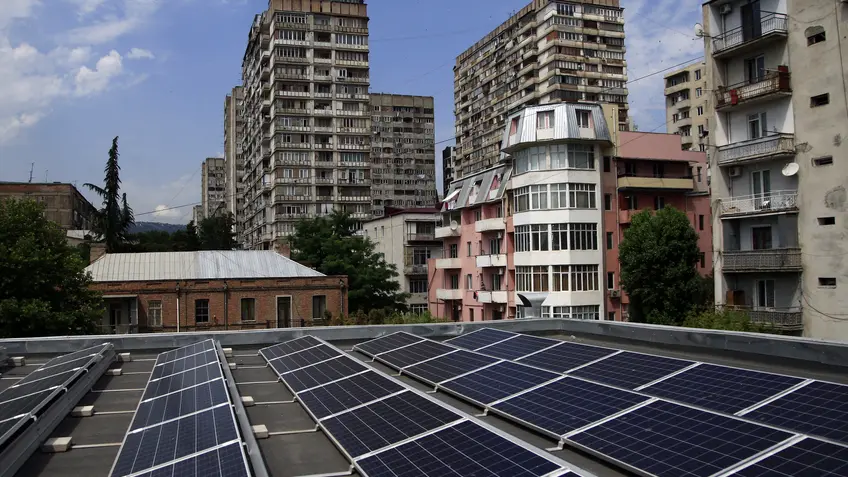Georgia's Low Emission Pathway: A Model for Developing Countries
Cover photo courtesy of the NDC Partnership
Read the full interactive version of this story and more in the 2023 edition of our Partnership in Action report.
Bordered by the Greater Caucasus Mountains and the Black Sea, Georgia is renowned for its natural beauty, rich cultural history and famed hospitality. However, its unique geographical position also makes it extremely vulnerable to the effects of climate change.
The frequency and severity of droughts, floods and landslides is projected to increase, with temperatures expected to rise more than the global average by the end of the century. These climatic shifts pose serious threats to Georgia's environmental and social heritage and burgeoning economic development, with vital sectors such as agriculture, forestry and tourism particularly vulnerable.
Aware of the serious implications, the Georgian government has been actively leading efforts to mainstream climate action policy. “Joining the Paris Agreement in 2015 was an extremely important step for Georgia to push climate policy into the national political agenda, thereby formalizing climate action into national development strategies and programs,” noted Ms. Nino Tandilashvili, First Deputy Minister of Environmental Protection and Agriculture (MEPA) of Georgia.
Georgia subsequently joined the NDC Partnership in 2017, submitting its revised nationally determined contributions (NDCs) in 2020 with support from the Partnership. These updated NDCs saw Georgia significantly raising its climate action goals, pledging an unconditional reduction of its greenhouse gas (GHG) emissions by 35% by 2030 compared to 1990, with this commitment possibly extending to a 50-57% reduction over the same period, conditional to international support.
The NDC Partnership continues to assist Georgia’s NDC implementation by coordinating partners and mobilizing resources. This support facilitated the development of Georgia's 2021-2023 Climate Action Plan (CAP), setting targets and indicators for emission reductions and climate integration across key sectors. The forthcoming updated CAP for 2024-2025 will enhance Georgia's NDC implementation with long-term strategies and short-term action plans.
Ms. Nino Tkhilava, Head of the Environment and Climate Change Department at the MEPA, expressed confidence in Georgia's preparations, attributing the success to significant experience in preparing the national Climate Change Strategy and CAP. “Although reaching net-zero emissions by mid-century seems ambitious, it is also an incredible opportunity for a developing country like Georgia,” noted Ms. Tkhilava. “I believe that steadily pursuing a low-emission development pathway will promote innovations and ensure robust investments in new technologies, creating additional economic opportunities and income for the country.”
Georgia’s Long-term Low Emission Development Strategy (LT-LEDS) strategically aligns the unique national situation with the principles of the Paris Agreement, serving as a compass towards GHG reductions with guiding mechanisms and measures tailored for key designated sectors.
Georgia aims to become carbon-neutral by 2050, although achieving this requires crucial new mitigation measures. The LT-LEDS outlines tentative ranges and targets for 2050 under various development pathways, elaborating on sector-specific mitigation actions. The transition to a low-carbon economy will necessitate significant financial investments, estimated at around USD22 billion for a net-zero transition scenario. Short-term implementation of climate actions is expected to require a further USD760 million annually, roughly 1.9% of annual gross domestic product (GDP).
“Georgia’s carbon-neutral goal will require significant financial investments,” noted Pablo Vieira, NDC Partnership Global Director. “Lack of financial resources is the primary barrier to Georgia’s sustainable and low-emission economic pathway, therefore effective mobilization of finance is critical to enabling the country to achieve and sustain the long-term positive impact of its transition to carbon neutrality.”
Despite the initial investment, long-term benefits include increased GDP and employment gains, potentially yielding an extra USD1 billion in gross value added (GVA) and 200,000 jobs by 2050. Decarbonization will also boost demand for mid- and low-skill workers with technical expertise, highlighting the importance of education and training in green skills.
Significant climate investments will further enhance Georgia's resilience by reducing import dependency, especially for the energy sector. This will curtail expenses for households, businesses and industry, while also paving the way for strategic technology investments for future green growth.
Georgia has significant renewable energy potential, particularly in hydro, wind and solar energy. The country also benefits from high solar radiation, with around 250-280 sunny days per year. Renewable energy sources hold immense potential for electricity generation, with opportunities for foreign investment.
Ms. Margalita Arabidze, Head of the Department of Energy Efficiency, Renewable Energy Policy and Sustainable Development at the Ministry of Economy and Sustainable Development of Georgia, highlighted the country’s potential to embrace green pathways leveraging its abundant renewable resources and strong commitment. She emphasized that Georgia would benefit locally from domestic emission reduction measures while also contributing to the global low-carbon transition.
“The NDC Partnership is committed to supporting Georgia’s robust low-emission development pathway,” noted Pablo Vieira. “Through increased ambition and collective implementation, Georgians stand to benefit greatly from a considered, long-term approach to national development that prioritizes diversity, job-creation, environmental stewardship and sustainability, creating an inspiring model for other developing countries around the world.”
